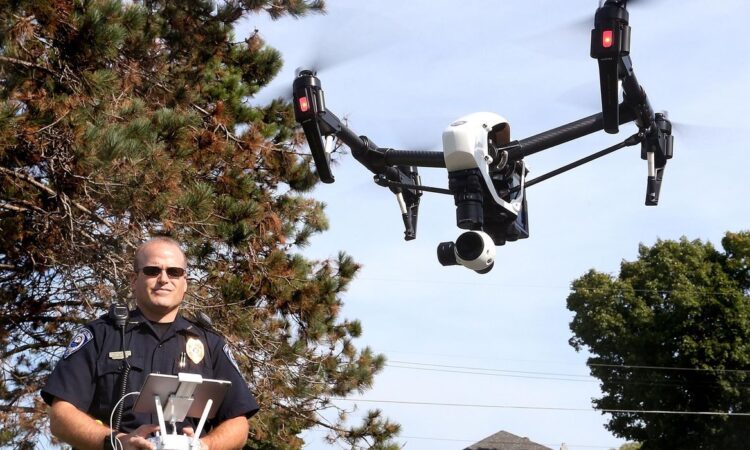
When the coronavirus pandemic struck, someone in the Mississippi government thought of drones.
The state’s workforce agency used some of its federal grant money to buy drones for a state college job training program.
One problem: Mississippi’s state auditor said the money didn’t fit the parameters for pandemic spending. Another problem: The state bought Chinese drones that the federal government has banned its own agencies from purchasing, the auditor said.
Other pandemic purchases on the watch of Mississippi’s Department of Economic Services included $61,800 for a virtual reality simulator, $1.1 million for a “robot intelligent manufacturing system” and $313,800 for two spindle lathes for students who had an internship canceled.
A total of 22 students used the lathe for a single semester before the internship restarted in the fall of 2021.
Most of the focus on pandemic misspending has focused on fraudsters who stole potentially hundreds of billions of dollars from special pandemic unemployment or small business loan programs.
SEE ALSO: $5.4 billion in pandemic loans were paid to suspicious Social Security numbers
But auditors are finding state and local governments also blew taxpayers’ money on wish-list purchases that strayed far beyond urgent pandemic needs.
• In Utah, one community spent hundreds of thousands of dollars on snow-making equipment for a snow tubing hill.
• Boston used pandemic money to buy vending machines that dispense condoms and syringes in high drug-use areas, figuring that users needed access to clean new supplies when the usual syringe dispensary was closed.
• Several communities reported using pandemic money to replace street signs.
• A number of jurisdictions built or upgraded pools, including Kentucky and Arizona cities that decided the time was right to install new water slides.
• Schools in Orange County, Florida, spent some of their pandemic assistance on a “virtual reality playground.” Hundreds of other jurisdictions bought playground equipment, figuring the feds’ money was the perfect way to upgrade their offerings.
SEE ALSO: Tens of thousands of federal employees bilked government of pandemic cash
• At least 15 localities have reported to the federal government that they bought drones with their pandemic assistance money.
Mississippi’s employment services agency isn’t listed in those records, which suggests the actual number of purchases of drones — or other iffy wish-list items — could be much higher.
The employment agency didn’t respond to inquiries from The Washington Times, but in its response to the state auditor, it said drones were an emerging technology and there will be a need for more drone pilots by 2025.
The auditor rejected that explanation, saying there was no “compelling justification” for why drone pilots were a critical pandemic need.
Mississippi’s money was part of a $350 billion earmarked to go directly to states and localities as part of Democrats’ $1.9 trillion coronavirus stimulus program, signed into law in the spring of 2021.
That was a year after the pandemic first washed over the U.S. and came amid an already improving economy.
Analysts at the time said the investment was far more than needed — or than the economy could handle. Some experts have tied soaring inflation rates of the Past two years to overstimulation wrought by the law, which also fired off stimulus checks to many Americans.
Acceptable uses of the state and local money are to cover budget holes left by the pandemic, offer premium pay to essential workers, assist industries and households still struggling with financial aftershocks, and invest in infrastructure such as water projects or broadband service.
The law says jurisdictions can still come up with new projects for money through next year, then they have until 2026 to spend the cash.
The administration says the money has done more than plug the budget gaps — it gave states and localities a chance to rethink their overall approach to spending, Jacob Leibenluft, the Treasury Department’s top pandemic relief official.
In a speech last week to the U.S. Conference of Mayors Mr. Leibenluft said states and localities budgeted $14.2 billion to pay for nearly 1,8000 housing projects, $10 billion for 3,000 “workforce” projects and nearly $4 billion for small business projects.
“SLFRF funds have allowed recipients to take a different approach this time around: to not only shore up local budgets — although that is undoubtedly crucial — but to take an opportunity to rethink how they can use funds to strengthen their communities over the longer run,” he said.
He singled out Boston — site of the condom vending machines — for special praise, saying the city has adopted performance metrics to evaluate every one of its spending projects.
There’s plenty of room to do more.
The Pandemic Response Accountability Committee, the consortium of inspectors general overseeing pandemic relief spending, says that states and localities have obligated just $149.5 billion of the $350 billion available. Just $107.9 billion has been spent.
For more information, visit The Washington Times COVID-19 resource page.






